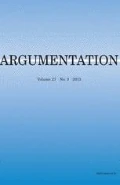Abstract
The present paper reports a set of experimental studies concerning the comprehension of French argumentative operators and connectives.
The first part is a presentation of the theoretical framework, the methodological problems and some of the most general results. Experiments were carried out in the perspective of the linguistic theory of argumentation developed by Anscombre and Ducrot. According to this theory, a number of devices in language are mainly defined by their argumentation function, i.e. by the types of discursive sequences and conclusions they involve. Three categories of such devices were examined: (1) operators like “presque” (almost), “à peine” (hardly), “au moins” (at least), etc. which give an argumentative orientation to the statement; (2) co-orientation connectives, like “même” (even), which relate two statements oriented towards the same conclusion; (3) counter-orientation connectives, like the concessive ones (“mais” (but), “quand même” (even so), etc.), which relate two statements oriented towards opposite conclusions. The data shed light on issues such as: What is the nature of the relationship between the informative and argumentative functions of different operators? Is there a hierarchical relation between the argumentative processes of “co-orientation” and “counter-orientation”? What is the role of negation in the processing of argumentative sequences?
The second part of the paper focuses specifically on the study of how 8 and 10 year-old children process “counter-oriented” statements. Five concessive connectives were studied: “mais”, “pourtant”, “quand même”, “même si”, “bien que”. The test was composed of two successive completion tasks: in one task the children had to choose the relevant context of complex sentences involving concessive connectives; in the other task they had to choose their relevant conclusion. Main results show a clear evolution in the performance of children between 8 and 10, suggesting that concessive strategies are not completely mastered at the age of 8. Differences among the concessive connectives studied were brought out: the item “quand même” obtained much better results than the other items with 8-year-old subjects; statements with “mais” seemed to be better processed in the conclusion task than in the context task, especially by 10-year-old subjects. These results are compared with other data obtained in some of the numerous studies on the production and comprehension of concessive connectives in various languages, and discussed from the point of view of argumentative theory.
Similar content being viewed by others
References
Anscombre, J. C.: 1973, ‘Même le roi de France est sage: un essai de description sémantique’, Communications 20, 40–82.
Anscombre, J. C.: 1983, ‘“Pour autant”, “pourtant” (et “comment”): à petites causes, grands effets’, Cahiers de Linguistique Francaise 5, 37–84.
Anscombre, J. C.: 1985, ‘Grammaire traditionnelle et grammaire argumentative de la concession’, Revue Internationale de Philosophie 155(4), 333–350.
Anscombre, J. C. and Ducrot, O.: 1977, ‘Deux “mais” en francais’, Lingua 43, 23–40.
Anscombre, J. C. and Ducrot, O.: 1979, ‘Lois logiques et lois argumentatives (II)’, Le Francais Moderne 1, 35–52.
Anscombre, J. C. and Ducrot, O.: 1983, L'argumentation dans la langue, P. Mardaga, Bruxelles.
Bassano, D. and Champaud, C.: 1986, ‘Children Processing of French Argumentative Connectives’, Second European Conference on Developmental Psychology, I.S.S.B.D., Rome, Italy, 10–13 Sept.
Bassano, D. and Champaud, C.: 1987, ‘Fonctions argumentative et informative du langage: le traitement des modificateurs d'intensité “au moins”, “au plus” et “bien” chez l'enfant et chez l'adulte’, Archives de Psychologie 55, 3–30.
Champaud, C. and Bassano, D.: 1987, ‘Argumentative and Informative Functions of French Intensity Modifiers “presque”, “à peine” and “à peu près”’, Cahiers de Psychologie Cognitive (in press).
Ducrot, O.: 1980, Les échelles argumentatives, Editions de Minuit, Paris.
Ducrot, O.: 1982, ‘Note sur l'argumentation et l'acte d'argumenter’, Cahiers de Linguistique Francaise 4, 143–163.
Ducrot, O.: 1983, ‘Opérateurs argumentatifs et visée argumentative’, Cahiers de Linguistique Francaise 5, 7–36.
Eisenberg, A. R.: 1980, ‘A Semantic, Syntactic and Pragmatic Analysis of the Acquisition of Conjunction’, Papers and Reports in child Language Development 19, 60–78.
Fillmore, C. J.: 1965, Entailment Rules in a Semantic Theory. Project on Linguistic Analysis Report 10, Ohio, Colombus.
Fraser, B.: 1972, ‘An Analysis of “even” in English’, in C. J. Fillmore and T. Langendoen (eds.), Studies in Linguistic Semantics, Holt, New-York, 151–178.
French, L.: 1981, But of course preschoolers understand the meaning of “but”. Paper presented at the 6th Annual Boston University Conference on Language development, Boston.
Horn, L.: 1969, A Presuppositionl Analysis of “only” and “even”. Papers from the Fifth Regional Meeting of the Chicago Linguistic Society.
Horn, L.: 1985, ‘Metalinguistic Negation and Pragmatic Ambiguity’, Language 61(1), 121–174.
Kail, M.: 1980, Etude génétique des présupposés de certains morphèmes grammaticaux; un exemple “mais”. Approches du Langage, Publications de la Sorbonne, Paris.
Kail, M.: and Weissenborn, J.: 1984a, ‘A Developmental Crosslinguistic Study of Adversative Connectives: French “mais” and German “aber” vs “sondern”’, Journal of Child Language 11, 143–158.
Kail, M. and Weissenborn, J.: 1984b, ‘L'acquisition des connecteurs: critiques et perspectives’, in M. Moscato and G. Piéraut-Le Bonniec (eds.), Le langage: construction et actualisation, Université de Rouen, Rouen, 101–118.
König, E.: 1985, ‘On the History of Concessive Connectives in English. Diachronic and Synchronic Evidence’, Lingua 66, 1–19.
Moeschler, J. and de Spengler, N.: 1981, ‘“Quand même”: de la concession à la réfutation’, Cahiers de Linguistique Francaise 2, 93–112.
Moeschler, J. and De Spengler, N.: 1982, ‘La concession ou la réfutation interdite. Approches argumentative et conversationnelle’, Cahiers de Linguistique Francaise 4, 7–36.
Piaget, J.: 1924, Le jugement et le raisonnement chez l'enfant, Delachaux et Niestlé, Neuchâtel.
Scott, C. M.: 1984, ‘Adverbial Connectivity in Conversations of Children 6 to 12’, Journal of Child Language 11, 423–452.
Stern, C. and Stern, W.: 1907, Die Kinderspache. Eine psychologische und spachtheoretische Untersuchung, Leipzig: Barth. (reed. 1928, Quelle Meyer).
Tannen, D.: 1977, ‘Well What Did you Expect?’, Proceeding of the 3rd Annual Meeting of the Berkeley Linguistic Society (BLS), 506–515.
Author information
Authors and Affiliations
Rights and permissions
About this article
Cite this article
Bassano, D., Champaud, C. La fonction argumentative des marques de la langue. Argumentation 1, 175–199 (1987). https://doi.org/10.1007/BF00182259
Issue Date:
DOI: https://doi.org/10.1007/BF00182259




